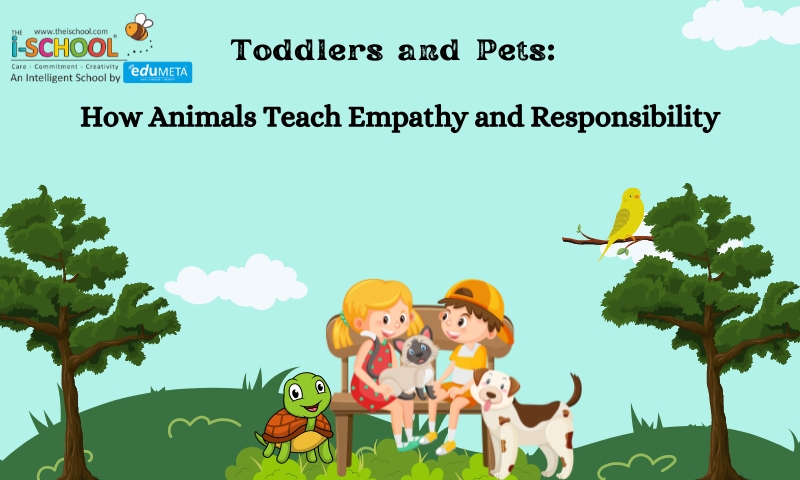Toddlers and Pets: How Animals Teach Empathy and Responsibility

Having a pet at home can be one of the most rewarding experiences for a toddler. Beyond the joy and companionship they bring, pets provide invaluable lessons in empathy, responsibility, and emotional development. As toddlers explore the world around them, the bond they form with pets becomes a crucial part of their learning process. In this blog, we’ll explore how animals can help shape a child’s understanding of empathy and responsibility from a young age.
1. Building Emotional Connections
One of the most significant ways pets influence toddlers is by helping them develop emotional connections. A child interacting with a pet learns how to read non-verbal cues, such as when a dog wags its tail or when a cat purrs. These simple actions teach toddlers how to interpret and respond to emotions in others. As they spend more time with their pets, toddlers begin to understand concepts like kindness, affection, and care—key components of empathy.
By observing how their pets react to certain behaviors, toddlers can better grasp how their actions affect others. If they pull the pet’s tail and it walks away, they start understanding that this behavior causes discomfort. This foundational emotional connection lays the groundwork for developing empathy towards both animals and people.
2. Learning Responsibility Through Caregiving
Toddlers may be too young to fully care for a pet independently, but including them in daily routines, such as feeding, grooming, and walking, fosters a sense of responsibility. By giving toddlers simple tasks—like filling the water bowl or holding the leash during a walk—they start to understand that pets rely on them for care and attention.
As children grow, they take on more responsibilities, learning the importance of consistency and commitment. Caring for a pet becomes a shared family activity, and toddlers learn that taking care of living beings requires effort and love. These early lessons in responsibility can translate into other areas of life, including schoolwork, friendships, and self-care.
3. Developing Empathy Through Gentle Touch and Play
Toddlers are naturally curious and sometimes don’t know their own strength. Pets offer the perfect opportunity to teach them about gentle touch and respect. Through playful interactions with their pets, toddlers learn how to be soft, kind, and patient. When they see their pet enjoying a gentle stroke or playful game, they realize the importance of treating others kindly and carefully.
Over time, they’ll carry this sense of gentleness into their interactions with peers, making them more sensitive to the feelings and needs of others. A toddler who learns to be kind to their pet is more likely to show empathy and kindness to classmates, friends, and family.
4. Developing Communication Skills
Another hidden benefit of having pets is that they help toddlers improve their communication skills. Toddlers often “talk” to their pets, giving commands like “sit” or calling them by name. Even though pets may not respond verbally, toddlers learn to express themselves clearly and confidently.
This interaction builds early language skills and boosts their confidence in communicating with others. Plus, having a non-judgmental companion, like a dog or cat, encourages toddlers to practice speech without fear of criticism, helping them build the foundation for better social skills.
5. Boosting Self-Esteem and Emotional Regulation
Pets offer unconditional love, and this bond provides toddlers with a sense of security and self-worth. Knowing that they are loved by their pet, regardless of their behavior, helps children develop a strong sense of self-esteem.
Moreover, pets can help toddlers regulate their emotions. For example, if a child is upset, simply petting or hugging a dog or cat can provide comfort and calm them down. This ability to soothe emotions with the help of a pet encourages toddlers to recognize and manage their feelings in healthy ways.
6. Cultivating a Lifelong Love for Animals and Nature
Toddlers who grow up with pets are often more connected to nature and the environment. The early bond they form with animals can foster a lifelong appreciation for living beings and a desire to care for the natural world. This early exposure to empathy and responsibility towards animals creates a lasting impact, shaping children into more compassionate and conscientious adults.
Conclusion
The relationship between toddlers and pets is a special one—filled with lessons of love, empathy, and responsibility. These early experiences not only help toddlers grow emotionally but also set them on the path toward becoming kind, responsible individuals. Whether it’s a gentle dog, a playful cat, or even a small pet like a hamster, having an animal companion at home enriches a toddler’s life in countless ways.
If you’re thinking about introducing a pet to your toddler, you’re not only welcoming a new family member but also providing your child with an opportunity to learn some of life’s most valuable lessons.
